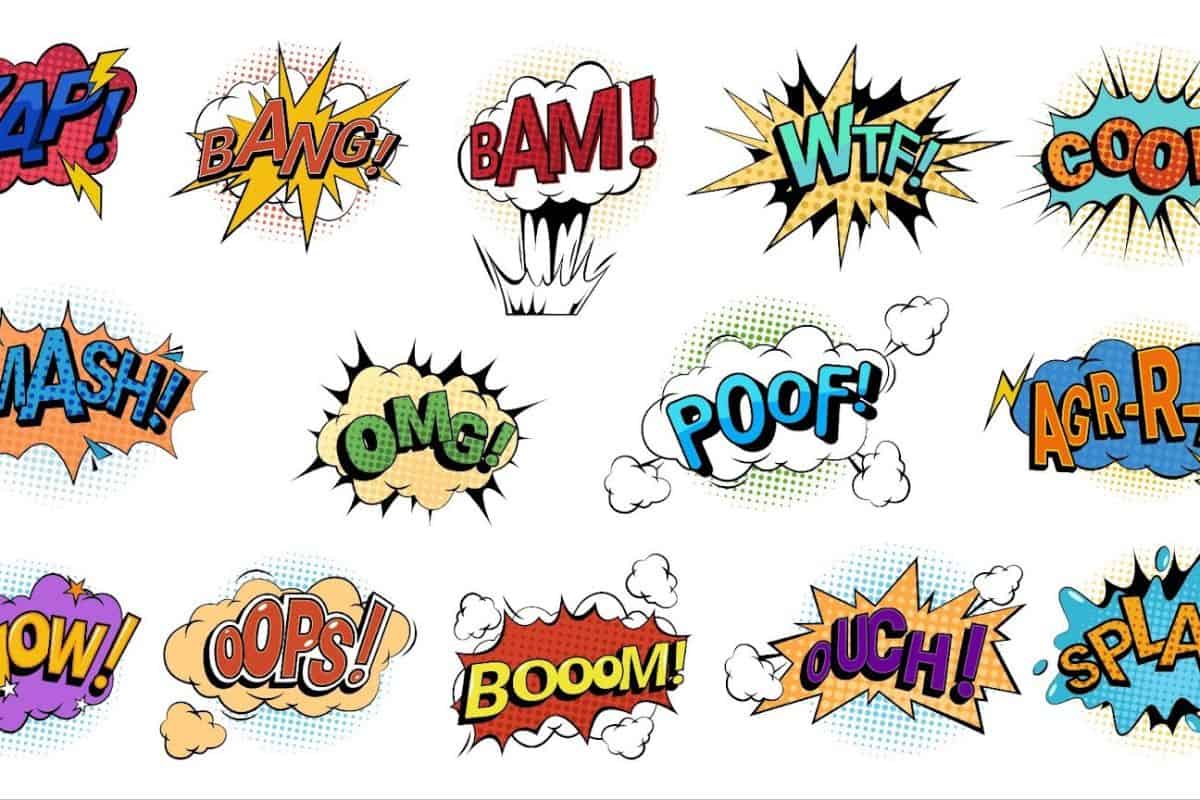Funny how we use some words every day that sound exactly like what they mean, without giving them a second thought.
I’m talking about onomatopoeia, words like buzz, crash, click, that slip into our speech quite very naturally.
They show up in poetry to add rhythm and in video games to intensify action. Adults lean on them to animate conversation. And descriptive literature practically is based on them.
In this article, I’ll explain what is onomatopoeia, how it is used, and how you can help your students enjoy learning it through hands-on, imaginative activities.
What Is Onomatopoeia?
The exact onomatopoeia meaning refers to words that imitate the sound they represent, for example:
- The “buzz” of a bee
- The “bang” of fireworks
- The “splash” when you cannonball into a pool
- The “meow” of a cat
Although they convey sound effects, many of them are actual words recognized by dictionaries that we use in writing and speech to recreate real-world noises.
In other words, onomatopoeia describes sound without audio. It brings text to life and helps readers “hear” the action.
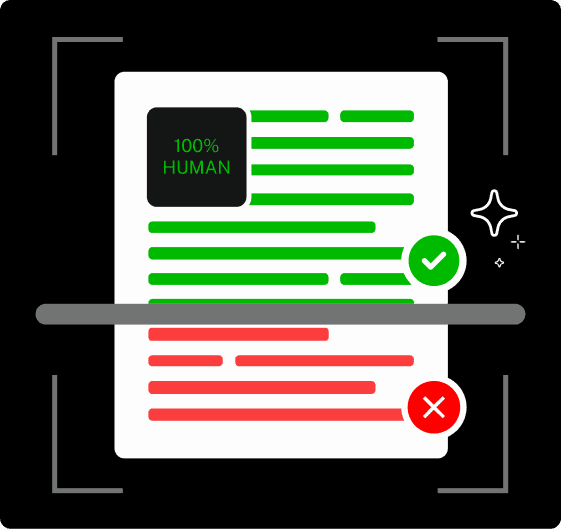

Never Worry About AI Detecting Your Texts Again. Undetectable AI Can Help You:
- Make your AI assisted writing appear human-like.
- Bypass all major AI detection tools with just one click.
- Use AI safely and confidently in school and work.
It is very commonly used in comic books, children’s books, poems, and descriptive writing.
What makes this concept interesting is that it shows up in conversations with kids and adults alike.
Children produce sounds much earlier than they start using full-word sentences, but many of these sounds are, in fact, onomatopoeic words.
As we grow, the usage becomes more subtle, but we still use it in everyday language fairly commonly.
For instance, see how Undetectable AI Chat provides age-appropriate explanations and examples of onomatopoeia for different audiences.
“Explain what onomatopoeia is to a 2nd grader. Use short sentences with simple words and give 3 fun examples.”
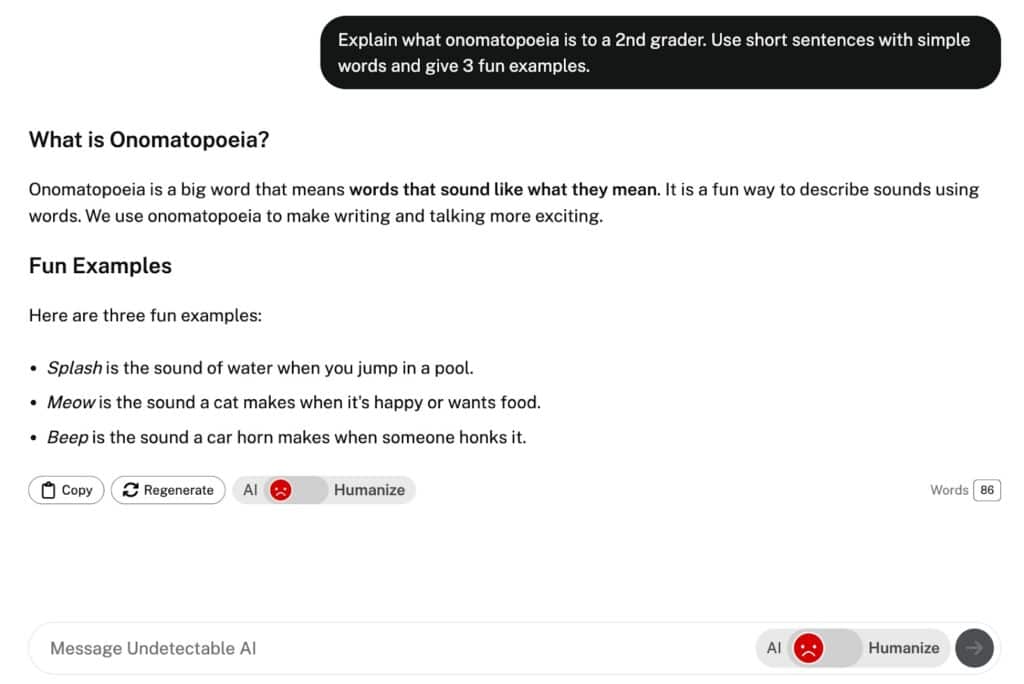
“Provide an onomatopoeia definition for middle school students. Include why writers use it, how it affects tone and imagery, and a few strong examples from poetry or prose.”
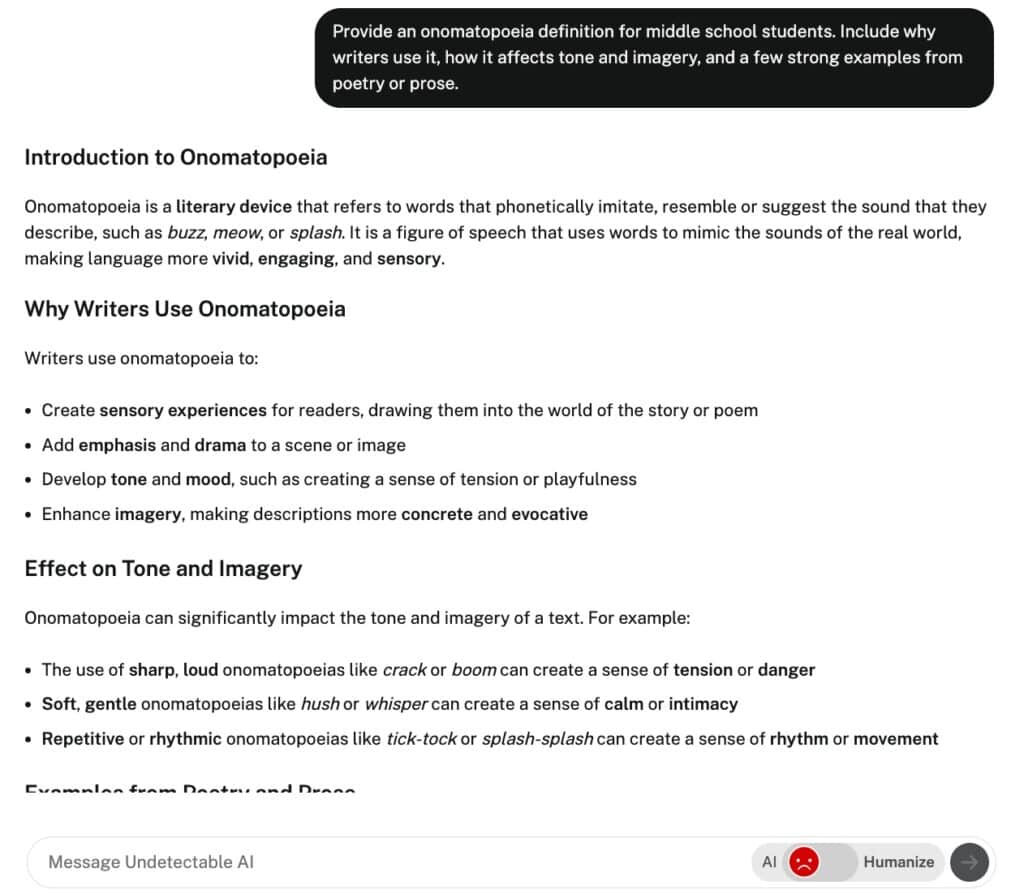
Onomatopoeia Examples in Everyday Language
Onomatopoeia is part of our everyday conversations in ways we don’t even think about.
These words slip out naturally when we react to a moment or just describe the world around us to tell a story.
You won’t realize it, but the moment you say something like “the door creaked open,” or “my phone buzzed,” you’re using onomatopoeia.
Similarly, if you say “I was so startled, I dropped the glass and it went crashing all over the floor,” while talking to a friend, you used multiple onomatopoeic words.
You didn’t plan that sentence, you just used the most natural words to describe what happened instinctively.
Now, let’s look at some context-specific onomatopoeia examples using Undetectable AI Chat.
Prompt: List some onomatopoeic words commonly used in [theme] scenes. Provide the word, what it imitates, and a short sentence showing how it’s used.
(Replace [theme] with ideas like ‘kitchen,’ ‘jungle,’ ‘superhero fight,’ ‘construction site,’ ‘rainstorm.’)
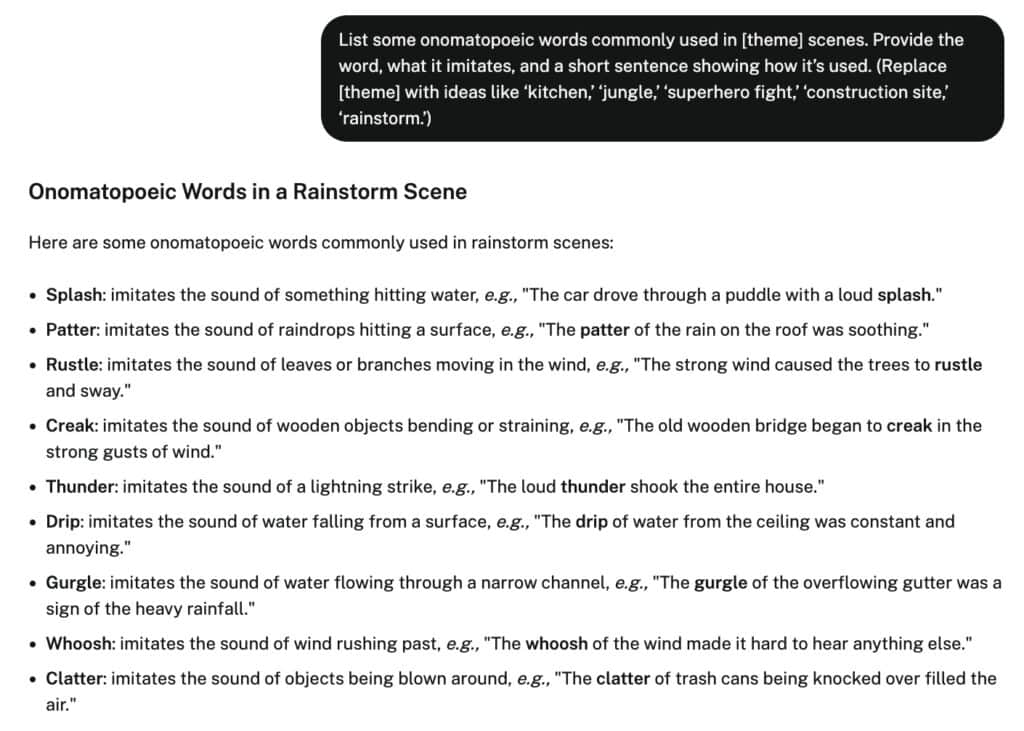
Onomatopoeia in Comics and Video Games
Comics operate in a visually static world. There’s no real motion, no real sound.
The artist and writer have to convince your brain that a punch landed with a THWACK or that a villain’s laser gun went PEW PEW.
The font size and style of size of the onomatopoeic letters in comic books are adjusted to translate intensity and emotion.
It’s also a kind of shorthand, a way to compress complex sensory moments into a single, intuitive visual marker.
Onomatopoeia lets creators compress sound, timing into words. A tick tick tick in a suspense panel suggests something is counting down, for example.
Now, in video games where sound is actually part of the experience, developers still use onomatopoeia to add to the aesthetic.
In retro games like Streets of Rage or Mega Man, the screen used to flash POW! or BLAM! with every attack.
Even in modern games, especially those with a comic book or arcade aesthetic like Cuphead, Borderlands, or Spider-Man: Into the Spider-Verse, onomatopoeia adds flair.
What’s also fascinating is how onomatopoeia evolves within these contexts. It’s not always literal. Sometimes it is completely fabricated to suit a specific action or aesthetic.
Splort, shwink!, etc aren’t dictionary words, but you know what they mean. They make abstract concepts feel concrete.
Onomatopoeia in Poetry and Literature
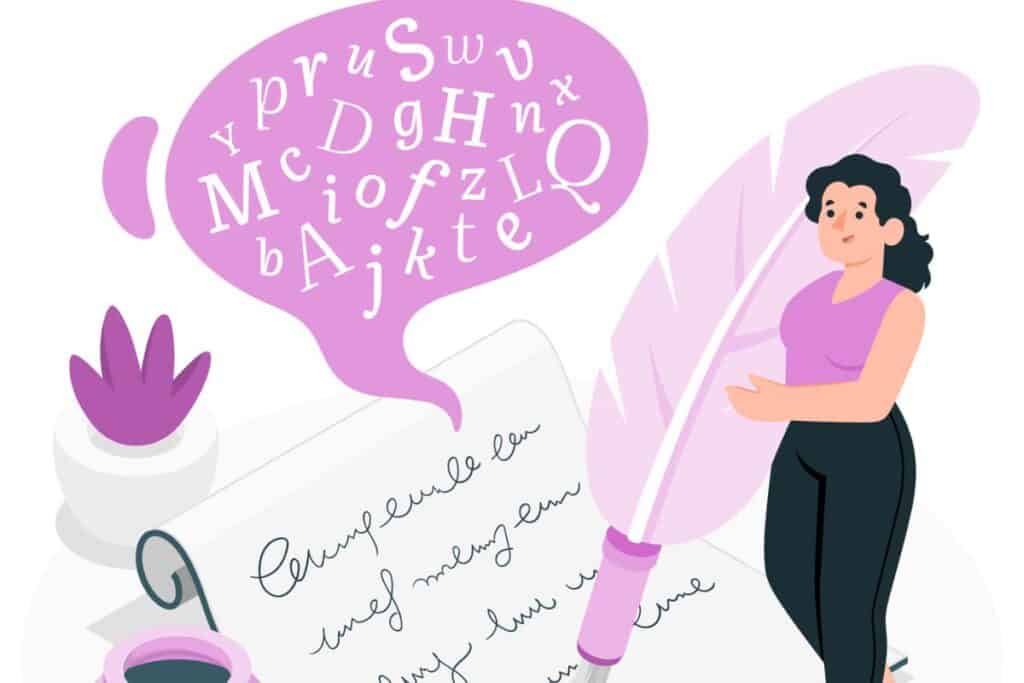
Poets are obsessed with sound. They weigh syllables like gold and hunt for rhythm in the mundane.
Take Tennyson’s “The moan of doves in immemorial elms, and murmuring of innumerable bees.” When you read this line, you can actually hear the bees being described.
In prose, it often blends into the narrative without drawing attention to itself.
A phrase like “the bacon sizzled in the pan” uses sizzle to instantly trigger a sensory experience of heat and that irresistible crackle.
When you read, “The door creaked open,” that word creaked immediately gives you a sound. You can almost hear the old hinges moaning.
Onomatopoeia can also be used to control the pace of a story or poem. A series of quick sounds like “click, clack, snap!” speeds up the scene and builds excitement.
In contrast, a slow, repeating sound like drip… drip… drip… makes things feel tense or creepy.
If you want help crafting sound-rich lines for poems or creative assignments, you can use Undetectable AI’s Poem Generator.
Give it a sound word like splash, hum, or crack and it will shape a poetic line or short verse around it.
It is a simple way to spark ideas before writing your final version in your own voice.
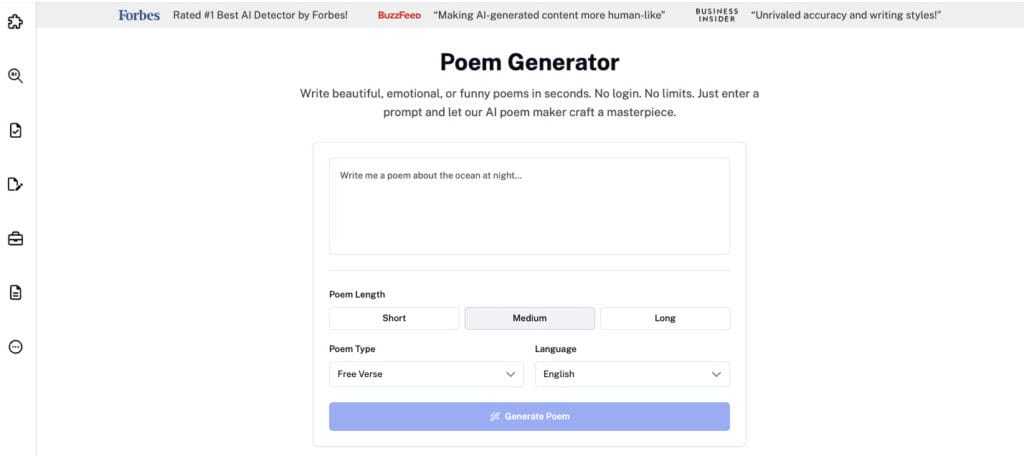
Classroom Activities & School Project Ideas
Onomatopoeia is one of the few language devices that instantly grabs students’ attention because it’s playful and oddly satisfying.
Here are some ways to make this concept stick with them, such that they actually enjoy learning it.
Onomatopoeia Sound Walk
This is a simple, sensory-rich activity where you take your students on a walk across the school.
Explain that during the walk, they’ll write down every sound they hear.
For example, if they hear a basketball bouncing in the gym, they may write “thump”, or the sound of a bird as “chirp.”
In this activity, you will not give your students a list of expected words. Let them be creative and descriptive. Encourage them to pause and focus entirely on their hearing.
You can lead the class through a loop around the playground, down the halls, past the cafeteria, etc, for variety.
Back in the classroom, ask each student to share the sounds they got, and as they do, write them on the board to create a collective onomatopoeic word wall.
Sound Match Challenge
Give your students a list of vivid onomatopoeic words to choose from.
Once students have chosen a word, they’ll build a list (or mind map) of nouns, objects, or phrases that could produce that sound in real life.
Let’s say a student picks the word “buzz.” Their sound source could include:
- A bee in a garden
- A faulty streetlight flickering
- An electric toothbrush
- A phone vibrating on a table
- A classroom projector warming up
- Someone whispering in a crowded hallway
Once everyone has created their sound-source lists, do a quick share-out.
You could also make it a guessing game where a student reads their list and the classmates guess the original onomatopoeic word.
Comic Strip
If there’s one place where onomatopoeia naturally belongs, it’s in comic books.
You can hand out a simple comic strip template of 3 to 6 blank panels to your students and have them plan a short, action-packed scene that naturally includes sound words.
Give them ideas to nudge their creativity, for example:
- Superheroes saving the day
- A day in the jungle
- A chaotic kitchen disaster
- A robot malfunctioning
- A monster chase in the school hallway
Then, ask your students to sketch the scene and add relevant text.
Once complete, give them time to present their comics and have fun in the classroom discussing them.
AI Tools to Practice and Perfect Onomatopoeia
Learning onomatopoeia is quite fun, but it’s not always easy for students to figure out when and how to use sound words effectively in writing.
Luckily, we’re now at the time where there’s an AI for just about anything, and education is no exception.
Undetectable’s AI Ask AI or AI Chat, for example, is a student-friendly assistant that, unlike a regular dictionary or Google search, gives usage suggestions in sentences and recommends better placement of sound words to improve flow.
Students can also use it to build practice prompts or exercises. For example, they can ask: “Give me five scenes where I can use onomatopoeia,” and then try writing each one using the suggestions.
Once done, check the work through it by pasting it into the tool and ask for instant, low-pressure feedback.

Also, since Undetectable Ask AI is made to blend naturally with the student’s voice, it avoids the stiff tone that AI writing tools tend to give.
Teachers can also use it to generate differentiated writing prompts based on different reading levels or interests.
See how our AI Detector and Humanizer work—find them in the widget below!
Conclusion
In summary, onomatopoeia is a fun literary device that brings life to writing, as you must have learnt by now.
We talked about the concept in great detail in this article, along with some hands-on classroom activities that help students understand and use such words meaningfully.
We also discussed how AI takes this learning further through personalized feedback and practical examples.
Now, use Undetectable Ask AI to augment your classroom learning and make your use of onomatopoeia more creative.
Sign up today!
